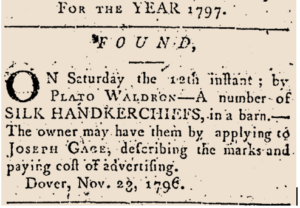Collect Day #20, DINAH, CHLOE AND PLATO WALDRON
God of all Life, we acknowledge the long-unseen lives of Dinah, Chloe and Plato Waldron, seeing in them the lives of too many who were enslaved in New Hampshire and Maine, across the young nation, and even around our world today. They labored, they suffered, they died. We name them when we can, often we still reap the benefits of their labor, in their deaths, help us to give them honor; in the name of God, Who Sees Every Hidden Person and Thing, we pray. Amen.

DAY #20, March 8, 2018
Dover
DINAH, CHLOE AND PLATO WALDRON
Jody Fernald
Most histories of Dover include the Waldron family. From enemies of Native Americans to eminent citizens, the Waldrons have always been included. Those who have not been included in the histories are the family’s slaves, including Dinah Waldron and her children, Chloe and Plato, enslaved in the household of Thomas Westbrook Waldron (1721-1785).
The enslaved people of Thomas Westbrook Waldron saw prosperity all around them. Waldron owned extensive landholdings in New Hampshire and Maine, had a close friendship with Gov. John Wentworth and served in many local offices. He owned the Globe Tavern and training grounds at the Portsmouth Plains, as well as numerous pews in the North Church parish in Portsmouth and First Parish in Dover. He rented property to the Rev. Jeremy Belknap, a man whose signature later appeared on the manumission papers of many formerly enslaved people in the area. A portrait by a Boston painter depicts Waldron in sumptuous clothing and surroundings. The painting currently resides in the Historic New England Collections. We have access to Waldron’s words and to his image.
There are no existing images of or written words by Dinah and her children. We do not know who fathered the children. We can only imagine their visages and their daily responsibilities. What we do know is that their lives were difficult and held no prospects for improvement. When Waldron wrote his will, he left his “Negro Woman Dinah and her two children Chloe and Plato” to his wife and her heirs forever. Dinah committed suicide by drowning just days after the death of Thomas Westbrook Waldron (Bill of Mortality for Dover from the Society of a Friends). She may have preferred death to the prospect of being passed on as property to the Waldron heirs with the expected separation from her children.
After Dinah’s death, prospects remained dim for Plato and Chloe. While Chloe remains an enigma in Dover’s history, Plato did leave some traces of his life. He was six years old at the time of his mother’s death. In 1797, eighteen-year-old Plato found some silk handkerchiefs and Joseph Gage, a local merchant placed an advertisement seeking the owner. When freed from slavery, Plato Waldron took a job as undertaker and sexton for the First Church in Dover in the early nineteenth century. He married twice, first to Elizabeth Cole of Somersworth in 1810 and second to Elizabeth Kelly in 1834. In 1810, Plato Waldron posted a notice in the Dover newspaper stating that he would no longer be responsible for the debts of his wife. While some feminist historians have found these notices to be published as a means of absolving men of their responsibilities, Plato Waldron’s estate inventory revealed numerous debts with local businesses. We don’t know the circumstances surrounding his debts. The population of color in Dover in the early nineteenth century was quite small, mostly made up of survivors from enslavement. In 1835, the body of Plato Waldron was found in the Cocheco River. One newspaper reported his death may have been an accident while bathing, or may have been suicide. There were no witnesses.
Thomas Westbrook Waldron was described as “a reluctant patriot” in revolutionary times. He imagined no life in freedom for his enslaved people. While we discuss the accomplishments of people of color in New Hampshire despite the odds against them, may we also take time to memorialize those who did not survive a brutal system and its aftermath.
